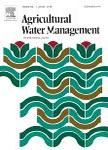版权所有:内蒙古大学图书馆 技术提供:维普资讯• 智图
内蒙古自治区呼和浩特市赛罕区大学西街235号 邮编: 010021

作者机构:China Agr Univ State Key Lab Efficient Utilizat Agr Water Resourc Beijing 100083 Peoples R China China Agr Univ Ctr Agr Water Res China Beijing 100083 Peoples R China Katholieke Univ Leuven Dept Earth & Environm Sci Div Soil & Water Management B-3000 Leuven Belgium
出 版 物:《AGRICULTURAL WATER MANAGEMENT》 (Agric. Water Manage.)
年 卷 期:2025年第309卷
核心收录:
学科分类:0828[工学-农业工程] 08[工学] 0815[工学-水利工程] 0901[农学-作物学]
基 金:National Natural Science Foundation of China [52279050, 52130902] Specialized Young Scientist Program of Bayannur Research Institute of China Agricultural University [2024BYNECAU012]
主 题:Water productivity Evolutionary multi-objective optimization Salinity control EPIC NSGA-III
摘 要:Improving water productivity (WP) from multiple perspectives is crucial for irrigated agriculture in arid areas, particularly due to challenges such as low crop WP, limited economic returns, and secondary soil salinization. In this study, a multi-objective simulation-optimization model is established for maximizing irrigation water productivity (IWP), economic water productivity (EWP), and nutritional water productivity (NWP) concurrently. Moreover, the Environmental Policy Integrated Climate (EPIC) crop growth model and water-salt balance equations are incorporated to readily simulate daily physical processes of crop growth and dynamic water and salt movement. The crop parameters required for simulating these physical processes are parameterized and calibrated based on existing studies. Subsequently, it s implemented in a case study within the Jiefangzha Irrigation Subarea, which is divided into 44 irrigation subsystems (basic irrigation decision-making units) to reflect the spatial distribution of input data. The Non-dominated Sorting Genetic Algorithm-III (NSGA-III) and Elite Opposition-Based Learning (EOBL) strategy are used to solve the problem and enhance the diversity of the randomly generated initial population accordingly, thus optimal solutions can be generated for supporting high- efficiency irrigation water use. Results indicate that (1) Optimal objectives (mean of the 44 irrigation subsystems) for IWP, EWP, and NWP are 6.72 Yuan/m3, 2.36 Kg/m3, 20041.7 Kcal/m3, with IWP increasing by 32.58 % over the status-quo. (2) Irrigation subsystems 41, 42, and 44 suffer severe salt accumulation, where salt- tolerant sunflowers should be prioritized for planting. (3) Crop root growth processes, sowing time, and growing periods have a strong influence on the salt concentration of actual root zone. Moreover, the proposed model emphasizes the influence of dynamic water-salt movement processes on crop growth and WP. Therefore, the study expands the research on multifac